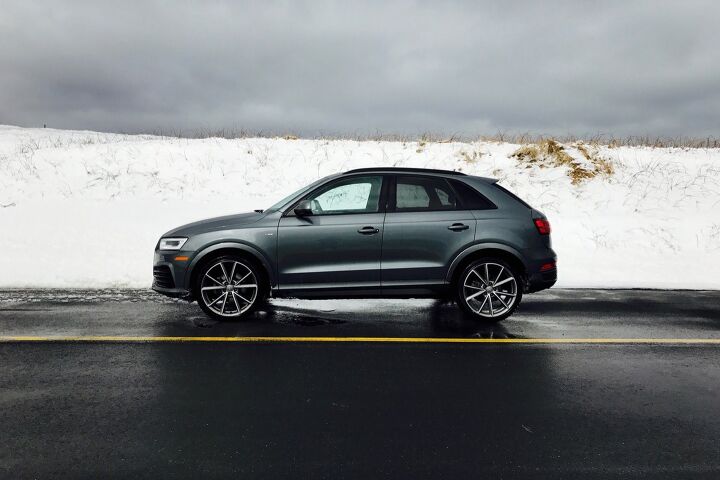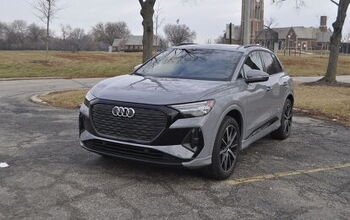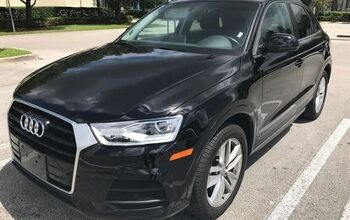2017 Audi Q3 Quattro Review - At What Cost?
2017 Audi Q3 Quattro
Some cars genuinely suck. There is essentially no price at which, for instance, wooden ride quality and inept handling and nonexistent acceleration and uncomfortable seats and disappointing fuel economy are worth the asking price. There are simply far too many decent alternatives for a vehicle such as, oh, I don’t know, the Mitsubishi Mirage.
Some cars, however, only suck in the context of their respective MSRPs. Take the Ford Flex we reviewed recently as an example. Though showing signs of age, it’s still a fine family hauler. But at the $50,000 as-tested price, the Flex is uncompetitive.
Then there’s this 2017 Audi Q3. Perhaps it’s an acceptable machine at its $33,875 entry price. But optioned up to $44,150, the aged Q3 may be guilty of simply resting upon the laurels of its four-ring badge.
Does the 2017 Audi Q3 suck, or does it only suck when it strays out of Single-A ball into the Major Leagues?
In some ways, it just sucks.
“Ride comfort” is not an applicable phrase. Nothing about the way the Q3 makes its way down the road will ever cause you to think of comfort. Though exacerbated in our test specimen by monstrous 20-inch wheels and their 255/35R20 tires, all Q3s are inhibited by a short 102.5-inch wheelbase.
Inside, other than a pair of downmarket shift paddles, material quality is of a sufficiently high quality. But the design as a whole screams 2009; 2011 if you’re being kind. Controls aren’t where they ought to be, there are numerous blank switches, the MMI architecture is un-Audi-like, and the seating position is more reminiscent of a bus than a TT.
Worst of all, particularly in a $44,150 Audi, are the refinement issues. The tires hum persistently, always working to get your attention. The 2.0-liter turbocharged four-cylinder is heard too often and too easily. Wind noise around the A-pillars is excessive.
It feels old. And so it should. The 2017 Audi Q3 represents the third model year for the Q3 in North America, but Q3 production began way back in 2011, and the Q3 rides on a platform that dates back to 2008.
There’s a certain charm, however. The Audi Q3 doesn’t merely feel like little more than an expensive Volkswagen. The interior layout is differentiated by a typical Audi darkness in the cabin, which contrasts with abundant light from the standard panoramic glass roof.
The standard 2.0-liter turbo is always willing, helped by a quick and smooth-shifting six-speed automatic.
Front-facing child seat space is tolerable considering the tidy exterior dimensions. Upgraded Bose audio is impressive.
From some angles, on these stunning 20-inch wheels, the Q3 looks a treat parked downtown on a snowy Friday night.
And in snowy conditions, fitted with Pirelli Sottozero winter rubber, the Audi Q3 proved to be a nimble and accomplished little runabout.
But even the Q3’s positive traits are contravened by corresponding negative traits. Sure, it doesn’t feel exactly like an upmarket Volkswagen, but a new Golf feels more premium.
Even many luxury buyers won’t feel the need to pay the premium Audi must charge for fitting the panoramic roof as standard equipment.
That willing 2.0-liter turbo doesn’t return the kind of acceleration you’ll find in a Mercedes-Benz GLA or BMW X1.
You can squeeze kids in the back, but the cabin is still snug in every direction, and cargo capacity falls 10 cubic feet shy of the X1.
Those 20-inch wheels that look so good are terrorized by anything other than perfect pavement.
And the Q3’s impressive winter-rubber snow performance is now downright common — Quattro doesn’t have the same meaning in 2017 than it had in 1987.
You can attempt to ascertain whether the Audi Q3 is a good car in the most general sense of the term. Debate amongst yourselves.
You can argue over the merits of the Audi Q3 as a competitive $44,150 subcompact luxury crossover. Let the debate rage on.
But it’s clear a second test, in a Q3 nearly identical to the Q3 I drove a year ago, produces a firm, undebatable verdict within the confines of another key deliberation: the 2017 Audi Q3 is not a good Audi. Not at $32,750; not at $44,150.
With signs of old age prevalent, disappointing on-road behavior, questionable interior design, and a second-generation Audi Q5 entering showrooms, the 2017 Audi Q3’s best before date is now a distant memory.
Timothy Cain is the founder of GoodCarBadCar.net, which obsesses over the free and frequent publication of U.S. and Canadian auto sales figures. Follow on Twitter @goodcarbadcar and on Facebook.
More by Timothy Cain
Latest Car Reviews
Read moreLatest Product Reviews
Read moreRecent Comments
- W Conrad I'm not afraid of them, but they aren't needed for everyone or everywhere. Long haul and highway driving sure, but in the city, nope.
- Jalop1991 In a manner similar to PHEV being the correct answer, I declare RPVs to be the correct answer here.We're doing it with certain aircraft; why not with cars on the ground, using hardware and tools like Telsa's "FSD" or GM's "SuperCruise" as the base?Take the local Uber driver out of the car, and put him in a professional centralized environment from where he drives me around. The system and the individual car can have awareness as well as gates, but he's responsible for the driving.Put the tech into my car, and let me buy it as needed. I need someone else to drive me home; hit the button and voila, I've hired a driver for the moment. I don't want to drive 11 hours to my vacation spot; hire the remote pilot for that. When I get there, I have my car and he's still at his normal location, piloting cars for other people.The system would allow for driver rest period, like what's required for truckers, so I might end up with multiple people driving me to the coast. I don't care. And they don't have to be physically with me, therefore they can be way cheaper.Charge taxi-type per-mile rates. For long drives, offer per-trip rates. Offer subscriptions, including miles/hours. Whatever.(And for grins, dress the remote pilots all as Johnnie.)Start this out with big rigs. Take the trucker away from the long haul driving, and let him be there for emergencies and the short haul parts of the trip.And in a manner similar to PHEVs being discredited, I fully expect to be razzed for this brilliant idea (not unlike how Alan Kay wasn't recognized until many many years later for his Dynabook vision).
- B-BodyBuick84 Not afraid of AV's as I highly doubt they will ever be %100 viable for our roads. Stop-and-go downtown city or rush hour highway traffic? I can see that, but otherwise there's simply too many variables. Bad weather conditions, faded road lines or markings, reflective surfaces with glare, etc. There's also the issue of cultural norms. About a decade ago there was actually an online test called 'The Morality Machine' one could do online where you were in control of an AV and choose what action to take when a crash was inevitable. I think something like 2.5 million people across the world participated? For example, do you hit and most likely kill the elderly couple strolling across the crosswalk or crash the vehicle into a cement barrier and almost certainly cause the death of the vehicle occupants? What if it's a parent and child? In N. America 98% of people choose to hit the elderly couple and save themselves while in Asia, the exact opposite happened where 98% choose to hit the parent and child. Why? Cultural differences. Asia puts a lot of emphasis on respecting their elderly while N. America has a culture of 'save/ protect the children'. Are these AV's going to respect that culture? Is a VW Jetta or Buick Envision AV going to have different programming depending on whether it's sold in Canada or Taiwan? how's that going to effect legislation and legal battles when a crash inevitibly does happen? These are the true barriers to mass AV adoption, and in the 10 years since that test came out, there has been zero answers or progress on this matter. So no, I'm not afraid of AV's simply because with the exception of a few specific situations, most avenues are going to prove to be a dead-end for automakers.
- Mike Bradley Autonomous cars were developed in Silicon Valley. For new products there, the standard business plan is to put a barely-functioning product on the market right away and wait for the early-adopter customers to find the flaws. That's exactly what's happened. Detroit's plan is pretty much the opposite, but Detroit isn't developing this product. That's why dealers, for instance, haven't been trained in the cars.
- Dartman https://apnews.com/article/artificial-intelligence-fighter-jets-air-force-6a1100c96a73ca9b7f41cbd6a2753fdaAutonomous/Ai is here now. The question is implementation and acceptance.
























![2016 Audi Q3 Quattro Review - New-To-You Utility [w/ Video]](https://cdn-fastly.thetruthaboutcars.com/media/2022/07/19/9247007/2016-audi-q3-quattro-review-new-to-you-utility-w-video.jpg?size=350x220)













Comments
Join the conversation
Isn't there a Lincoln that looks almost exactly the same as a Q5, and drives better than the Q3, for about $35k?
Better feature content, reliability, and warranty in a Buick Encore.